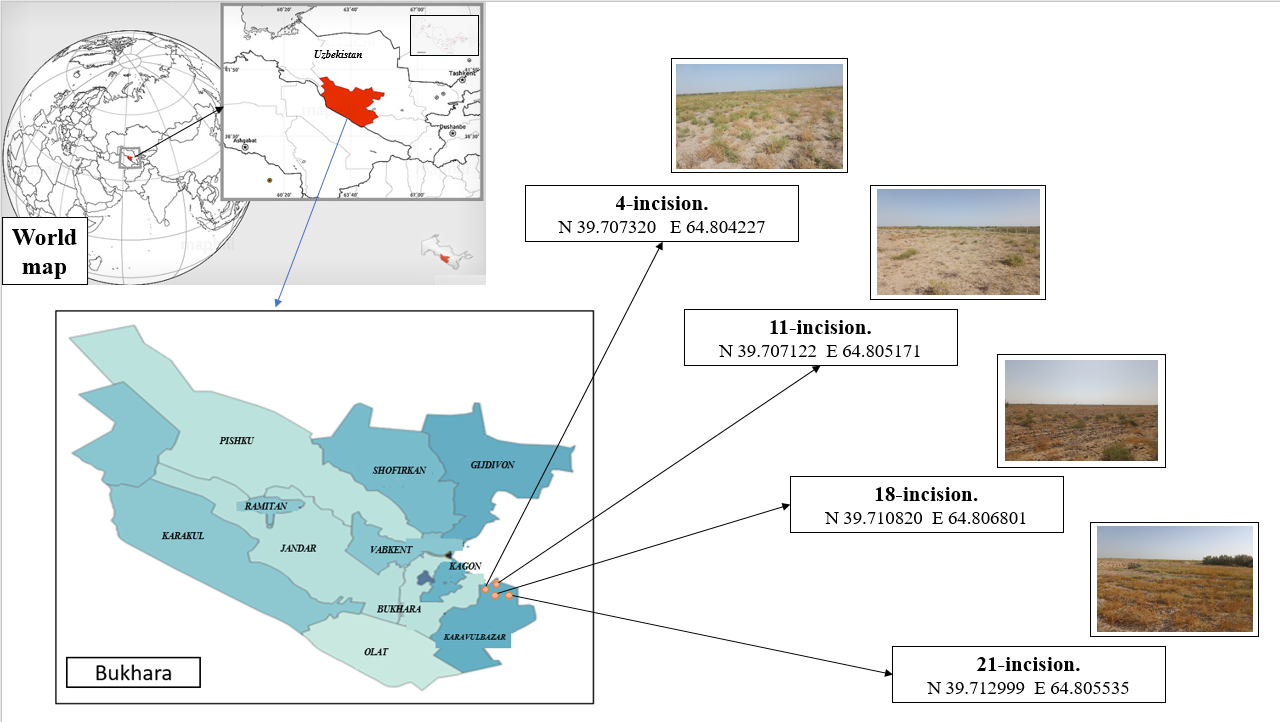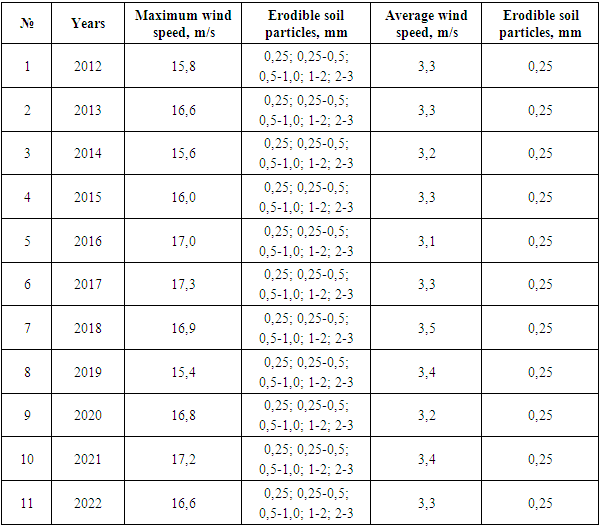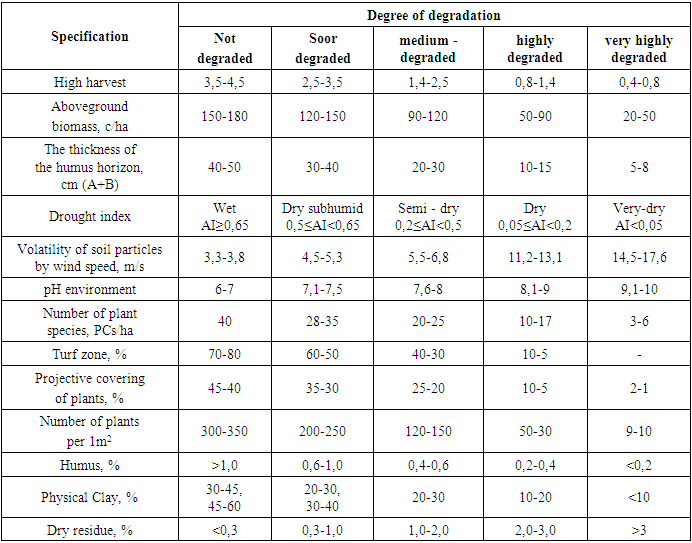-
Paper Information
- Previous Paper
- Paper Submission
-
Journal Information
- About This Journal
- Editorial Board
- Current Issue
- Archive
- Author Guidelines
- Contact Us
International Journal of Genetic Engineering
p-ISSN: 2167-7239 e-ISSN: 2167-7220
2024; 12(6): 104-110
doi:10.5923/j.ijge.20241206.07
Received: Nov. 2, 2024; Accepted: Nov. 23, 2024; Published: Nov. 27, 2024

Criteria for Erosion and Degradation Factors of Desert Pasture Soils
Nabieva Gulchekhra Mirergashevna1, Nurgaliev Najmiddin Abdumajidovich2
1DSc., Associate Professor, Departament of Soil, National University of Uzbekistan named after Mirzo Ulugbek, Tashkent, Uzbekistan
2Researcher Departament of Soil, National University of Uzbekistan named after Mirzo Ulugbek, Tashkent, Uzbekistan
Correspondence to: Nabieva Gulchekhra Mirergashevna, DSc., Associate Professor, Departament of Soil, National University of Uzbekistan named after Mirzo Ulugbek, Tashkent, Uzbekistan.
| Email: |  |
Copyright © 2024 The Author(s). Published by Scientific & Academic Publishing.
This work is licensed under the Creative Commons Attribution International License (CC BY).
http://creativecommons.org/licenses/by/4.0/

This article presents the research on the deterioration of soil properties under the influence of wind erosion in the Todakol massivi in the northern part of Qorovulbazar district of Bukhara region. The work explores the natural geographic location of the research area, soil cover, vegetation world distribution, climate conditions, and drought levels. The impact of wind erosion on the soils of the research area and the number of naturally distributed grazing plants were calculated through the 4 × 100 transect method. The laboratory studied soil salinity types, soil salinity levels, chlorine ion, dry residue. In particular, soil erosion due to the wind in the area and the amount of easily soluble salts in water were determined and factors that cause degradation processes evaluation criteria improved. As a result, an increase in wind speed and, as a result, erosion of soil particles in the protected area of the Bukhara region, a decrease in soil fertility was observed. In the last 10 years, the annual drought rate has dropped to the dry and hyper-dry type, and the maximum wind speed is. 0,25; 0,25-0,5; 0,5-1,0; 1-2; 2-3 caused the mm particles to be blown away, while the average wind speed was 0.25 mm particles.
Keywords: Wind erosion, Desertification, Soil degradation, Soil salinity, Flora
Cite this paper: Nabieva Gulchekhra Mirergashevna, Nurgaliev Najmiddin Abdumajidovich, Criteria for Erosion and Degradation Factors of Desert Pasture Soils, International Journal of Genetic Engineering, Vol. 12 No. 6, 2024, pp. 104-110. doi: 10.5923/j.ijge.20241206.07.
1. Introduction
- In recent years, soil pollution, increased salinization and desertification, water and wind erosion have affected the loss of the fertile soil layer. Such processes are clearly felt as a result of the soil spread in the basins of the Zarafshan River and anthropogenic effects on them [11,19]. The experience of using remote sensing services of soil and vegetation cover in arid regions has been widely used, including in 2020 and 2021, unfavorable weather and unscientific use of pasture lands caused the rise of dust storms, which resulted in the sand cover of pastures and accelerated the degradation process [5,27]. Analysis of modern desertification dynamics using geo-information technologies and aerospace data has shown that the area of degraded and desert lands in the region is increasing due to the influence of human factors [12]. Desertification and degradation of drylands have been studied through years of research to quantify the desertification process [13].In recent years, the degradation processes of sandy desert grasslands have become a serious problem in some regions. This process depends on several factors. Quantitative assessment, the effects of the degradation processes of arid windy sandy areas on soil properties and their changes have been studied [2]. Effects on desert soils resulted in reductions in soil microbial biomass, enzyme activity, and nematodes [32,18]. Dunes were formed as a result of wind erosion in desert regions where vegetation is sparse [35]. In recent years, as a result of sudden changes in climate, the level of soil and vegetation degradation in the sandy desert areas has reached 35.7%, and it has been determined that the current state of grassland ecosystems in the Kyzylkum desert will undergo serious changes [33]. The condition of grassland ecosystems in the sandy desert massiv was comprehensively evaluated, and according to the research results, the development of degradation processes and the loss of natural fertility were observed as a result of irregular use of pastures [4,22]. In the desert zone, pastures, which are being excessively lost due to long-term monitoring of their land, occupy a small part of the Caspian lowland [16,17]. Biodiversity has been significantly damaged by changes in soil properties in the desert region by disrupting the water requirements of plants [29,6]. The process of desertification is active in various regions and is considered a major problem in changing the soil and vegetation cover [3]. FAO and UNESCO organizations have studied the desert region into several groups and named them as gray-brown, barren, sandy desert soils [21]. In the Bukhara oasis, scientists conducted extensive research on the formation of desert soils, the hydrogeological regime of their origin, climate, and soils [26]. In order to study the degradation of sandy desert soils, their distribution, mechanical composition, humus content, presence of total and mobile nutrients in the soil, salinity level were studied [1,7,24]. Based on research conducted in desert areas, it is scientifically proven that various ecological problems and changes in vegetation cover are caused by relief features, soil-forming rocks, and moisture conditions [28,10,1]. It has been scientifically proven that the soils of the desert zone located in different regions of Kazakhstan differ in terms of regional climate characteristics, morphogenetic and chemical properties of soils, organic substances in their composition, and their group composition [23,9]. The formation processes of sandy desert soils, the formation of soils, their specific water regime and capillarity create a specific water regime [14,34,31]. It has been found that plants in desert soils are severely damaged by wind erosion [30]. In the desert region, the reduction of vegetation as a result of degradation leads to the activation of soil salinization [20,15].
2. Materials and Methods
- In the study of the properties of degraded sandy desert soils distributed in the Todakul massiv of the Qorovulbazar district of Bukhara region, the generally accepted profile in soil science was studied on the basis of methods such as genetic, morphological, comparative geographical, and on the basis of methods generally accepted in laboratory conditions. V. Sayfutdinova's study guide was used to take soil samples and determine the amount of water-soluble cations and anions in the soil [25]. The following work was carried out under field conditions:Ø studies were carried out on the study of the natural geographical location, soil cover, distribution of vegetation, and ecological conditions of the research area;Ø studies of climate conditions and drought level of the research area were carried out;Ø work was carried out to study the effect of wind erosion on the soils of the research area;Ø soil samples were taken from the research area;Ø the number of naturally distributed pasture plants in the research area was calculated using the 4x100 transect method.Soil analyzes were carried out in the following ways:Ø determination of soil salinity types according to Yu.P. Lebedev's classification;Ø determination of soil salinity according to O.K.Komilov, A.U.Akhmedov classification;Ø chlorine ion according to Mor's method;Ø dry residue based on evaporation of the solution and weighing of the precipitate;Ø correlation coefficient was performed in Microsoft Excel program and statistical analysis of obtained results was performed in Excel STAT interface.Flora distributed in the study area. The geographical distribution of plants in the research area is divided into two groups: that is, plants distributed in sandy desert and irrigated areas. Grasslands are the main part of the plants scattered in the sandy deserts of the oasis. These plants also protect the soil from wind erosion. Their vegetation period is short, 210-215 days plants such as white haloxylon (Haloxylon persicum L.), black haloxylon (Haloxylon aphyllum L.), sagebrush (Artemisia tenuisecta L.), tamarisk (Tamarix hispida L.), harmel (Peganum harmala L.), seta (Salsola sclerantha L.), alhagi (Alhagi sparsifolia L.), sagebrush (Salsola arbuscula L.), black redroot pigweed (Amaranthus retroflexuss L.), sedges (Carex physodes L.), downy brome (Bmomus tectorum L.), barley (Eremopyrum Orientale L.), salty crabgrass (Aeluropus litoralis L.), alhagi (Alhagi psudoalhagi L.) are common (Fig. 1).
 | Figure 1. Plant species distributed in the study area |
 | Figure 2. Geographic location coordinates of the research area, 2024 |
3. Results and Discussion
- Indicators of soil deflation in the study area under the influence of wind. Today, desertification and land cover degradation caused by climate change is one of the major problems around the world. This process causes a number of problems related to the formation of sandy soils, especially in areas with limited water resources, including many areas of Bukhara region. In the soils of the Bukhara region, the fertile upper part of the soil is blown away by the deflation processes, especially under the influence of the wind. According to the information of the Hydrometeorological Service Center of the Republic of Uzbekistan, it was observed that during the period of 2012-2022, due to the influence of wind erosion, soil particles with a size of 0.25 mm were regularly eroded by wind (Table 1).
|
 | Table 2. The amount of easily soluble salts in the soil of the study area |
|
4. Conclusions
- In the research area, the annual precipitation has decreased by 39.8 mm in the last 10 years, annual evaporation has increased by 116.2 mm, the degree of drought has dropped to the dry and hyper-dry type. In the period from 2013 to 2022, the maximum wind speed (16.6-17.3 M/s) increased to 1.7 M/s. Maximum wind speed in 10 years 0,25; 0,25-0,5; 0,5-1,0; 1-2; 2-3 caused the MM particles to be blown away, while the average wind speed was 0.25 mm particles.The data analysis shows that soil layers in the northern part of Qorovulbazar district of Bukhara region over the years, the increase in wind speed and as a result the erosion of soil particles is one of the main factors that reduce soil fertility. In the fight against soil erosion, the force of the wind can be reduced by planting trees and shrubs. These measures can be effective in maintaining soil fertility and preventing wind erosion.According to the degree of salinity, it was determined that the soils are weakly saline, and the type of salinity belongs to chloride sulfate (ch.s) and sulfate chloride (s.ch) types. These results indicate that the soils in the area are in the early stages of the salinization process, and the composition and amount of salts may have a negative impact on soil fertility. Therefore, it is necessary to take these factors into account when carrying out agricultural activities on the soils of the area. Special agrotechnical measures are required to take additional reclamation measures and increase soil fertility.The criteria for assessing the factors that cause degradation processes have been improved to a level corresponding to the research area, and sandy desert soils, whose assessment criteria have been analyzed and studied for 13 different indicators and 5 different levels of degradation, have shown that soils are moderately and strongly degraded.
 Abstract
Abstract Reference
Reference Full-Text PDF
Full-Text PDF Full-text HTML
Full-text HTML
